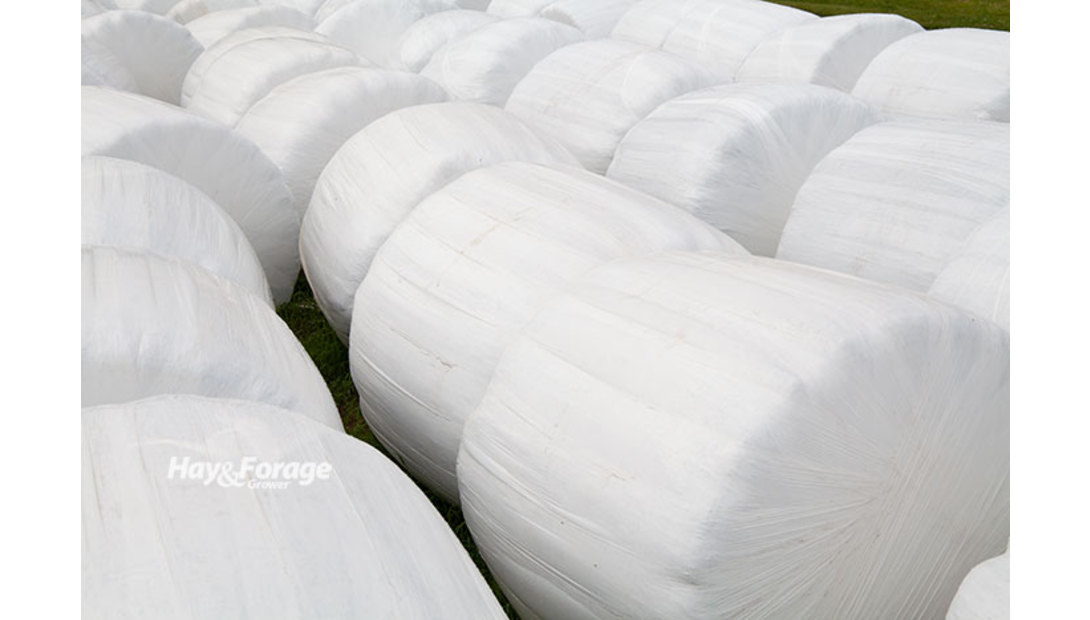Wayne Coblentz, the author, donated $13,335 to this study.

Farmers attempting to bale dry hay while fighting weather that is too wet and/or too cool for drying to 15% to 17% moisture may have another option.
Alfalfa Checkoff-funded research found that wrapping relatively dry mixed-forage round bales with plastic film cuts off the crop’s oxygen supply, stops respiration, and preserves the forage as minimally fermented baled hay. “The large hay packages commonly used today are particularly prone to spontaneous heating, resulting in dry matter losses, poorer nutritive value, and, in extreme cases, spontaneous combustion,” said former USDA-ARS research dairy scientist Wayne Coblentz.
“It was striking the heating control we got in those bales with the elimination of respiration by simply restricting air access with plastic,” he added. Coblentz, recently retired as research leader at the U.S. Dairy Forage Research Center based at Marshfield, Wis., conducted the experiment with Matt Akins, who now holds that position, and Burney Kieke, a biostatistician with the Marshfield Clinic Research Institute.
The colleagues compared alfalfa-orchardgrass forage baled in 5-foot diameter round bales at 25% moisture under four scenarios. Bales were wrapped with seven layers of plastic, treated with a propionic acid-based preservative and wrapped in plastic, left unwrapped but treated with propionic acid, or left unwrapped without preservative.
Each bale was weighed, core-sampled, and stored for 84 days before plastic was removed from wrapped bales. All were then again weighed and core-sampled. Moisture concentrations, pH, and nutritional values were measured, as well as the fermentation within wrapped bales evaluated.
“People still would like to bale dry hay for all kinds of different reasons, but it’s often difficult to get material as dry as it needs to be before baling in the North Central region,” Coblentz explained. “With hay packages larger in size, the problem of spontaneous heating and associated losses of dry matter and nutritive value have increased.”
The researchers had noticed a recent trend toward baling silages drier than 50% to 60% moisture, and some of their other experiments had successfully baled forage crops at fairly low moisture concentrations (30% to 35%). Coblentz added, “With this specific experiment, we asked: ‘If we can get this hay down to 25% moisture, what happens if we just wrap it in plastic? How effective would that be?’
“It turns out it was very effective,” Coblentz said.
Less heating
Wrapped bales, whether treated with preservative or not, reduced heating and minimized nutrient losses. “Because there was little moisture in these bales, they didn’t ferment very much, which means basically you’re preserving them by excluding air,” he added.
Unwrapped bales accumulated considerably more heating units throughout storage, regardless of whether they were treated with a preservative or not. However, acid-treated unwrapped bales accumulated fewer heating units at 30 and 45 days post-baling, and dry matter recovery was improved significantly compared to unwrapped bales without preservative.

After 84 days of storage, the wrapped bales had plastic removed and were monitored for another 33 days for aerobic stability. “This is where propionic acid has really shown a lot of benefit. The exposed, fermented bales that were treated with preservative exhibited characteristics that were consistent with improved aerobic stability, and that’s similar with what we found in other experiments,” Coblentz said.
Farmers whose bales will stay uncovered for a time before being fed, or who plan to market those bales, may want to consider the dual application of acid with plastic to improve aerobic stability. But this also needs to be weighed against cost, Coblentz explained. He suggested that preservatives and plastic wrap be considered, particularly when weather conditions are less than optimal for haymaking.
The experiment was conducted just before Coblentz retired. He’d like to see someone repeat it for consistency’s sake and possibly with grass hays. •
This article appeared in the March 2023 issue of Hay & Forage Grower on page 16-17.
Not a subscriber? Click to get the print magazine.


